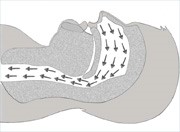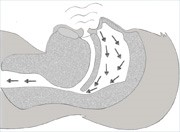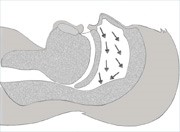|
Obstructive Sleep Apnea
Obstructive sleep apnea (OSA) stops you from breathing normally at night. Your airway can partly or completely during sleep. This can happen because the tongue and soft tissues at the back of the throat relax and fall back and block the airway. Fatty tissue can also contribute to the airway blockage.
If you have OSA, you probably repeat this cycle while you sleep:
First, you may sleep quietly and breathe normally. The air in your airway flows easily to your lungs.

Then, you begin to snore loudly. This is a sign that your airway is partly blocked. If the blockage worsens this may affect the amount of air that can enter your lungs. This means your oxygen level can drop and your carbon dioxide level can increase.

Next, your airway closes off completely. No air reaches your lungs. Your brain is telling you to breathe as usual, but you cannot because your airway has closed off. After a pause of 10 seconds or more, your brain realizes you haven’t been breathing, so it jolts you awake enough for you to take a breath. You take in a big gasp of air and start breathing again.

This cycle can continue through the night: you breathe quietly; you snore; you have a pause in your breathing; you gasp for breath; and you start breathing again. Some people have hundreds of sleep apnea events a night. This means many interruptions of sleep. You cannot get the rest your body needs, when this occurs.
Mild, Moderate or Severe Sleep Apnea?
- Sleep specialists categorize sleep apnea by the number of events that occur each hour of sleep:
- Mild sleep apnea – 5 to 15 events per hour
- Moderate sleep apnea – 15 to 30 events per hour
- Severe sleep apnea – over 30 events per hour
Other factors that determine how sleep apnea is impacting you:
- How sleepy you feel when you are awake
- How low your oxygen level drops
- How long your oxygen level stays below 90%
- Other medical conditions you may have, such as heart disease
